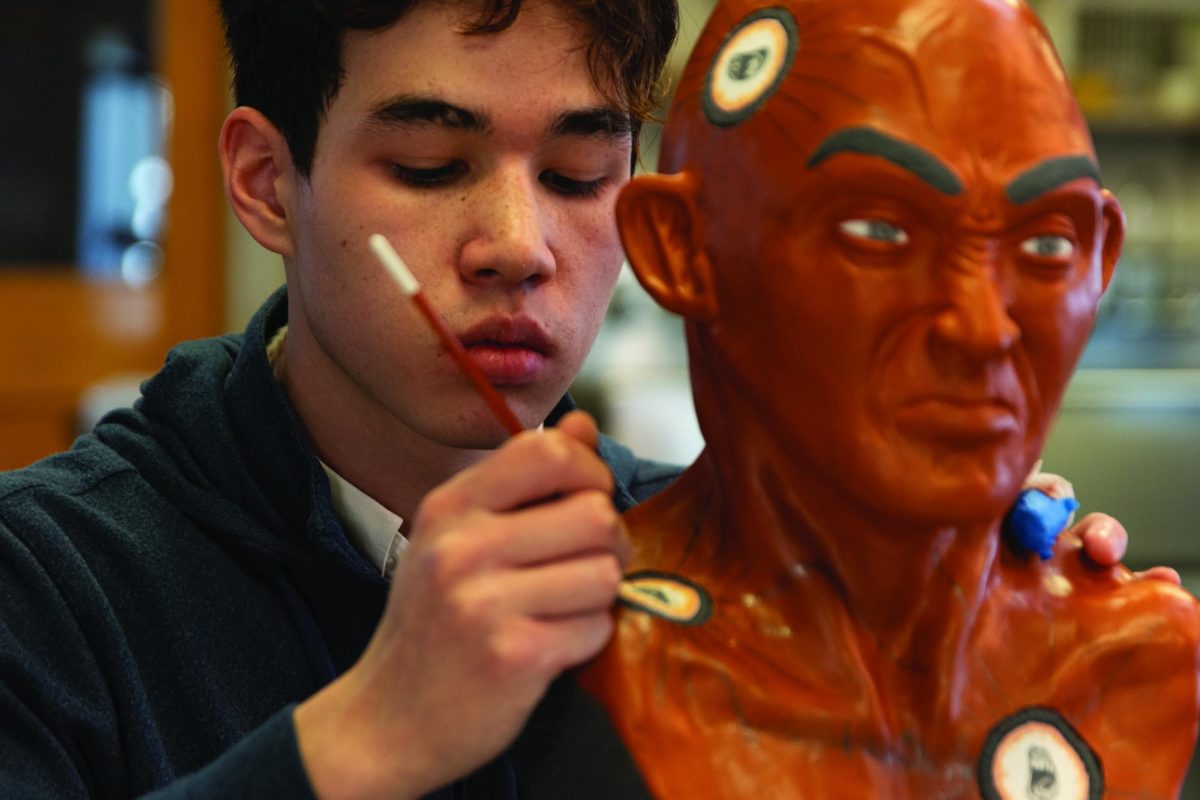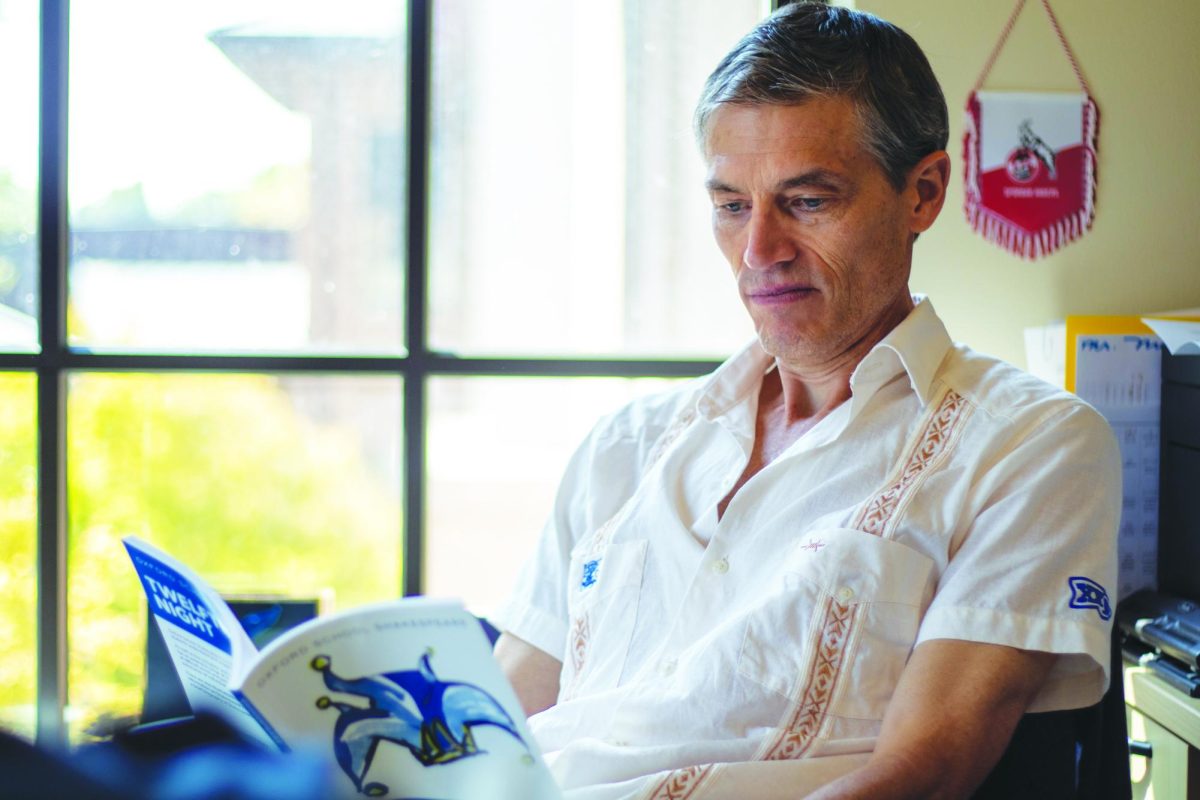It’s 10 p.m. Maybe 11.
The space around him is cluttered with pots, vases, sculptures, busts. He’s been kneading and shaping the clay for the past week. Just last night, he’d spent hours shaping it to his heart’s content — rolling, pinching, coiling. He’d gone into the ceramics workshop every free period. Long weekends. Even the snow days.
To sophomore Taiting Zhou, the art of ceramics is almost a ritual; the constancy is reassuring. Right now, he’s just begun the long process of creating a piece of art: a cup.
For the next step of many, he would have to glaze the piece with variations of the blues and reds that had taken dozens of trials to get just the right shade.
Maybe it cracks in the furnace, which heats up to about 1830 degrees Fahrenheit. Hopefully it doesn’t. It’s already Zhou’s fifth iteration of this small cup.
He lifts and turns the piece in every possible direction, inspecting it for nicks and asymmetry.
And every single time, Zhou finds something wrong with the piece he’s working on: the top not a perfect circle, the walls not thick enough, the color too glaring. He likes to say that 5 percent of the work he starts actually ever gets finished.
“I’ve thrown a bunch of stuff at these walls in pure frustration,” Zhou said, motioning to the dimly lit workshop around him. “Sometimes, it’s hard to keep being motivated.”
But Zhou isn’t alone. In the ceramics studio, there are other artists who work just as hard. Stay just as late. Get just as angry.
The people around him, specifically his fellow sophomores, keep him motivated.
Trial and error.
A saying that all of these ceramics-loving sophomores live by. They help each other succeed by engaging in a constant competition. Together, they take on trials and are constantly met with errors.
“That’s the beauty of ceramics,” Zhou said.
Sophomore Tyson Diep uses ceramics as a channel for his desire to create. Some artists, even his classmates, face long periods of creativity block — they haven’t completed anything for months. But Diep visualizes potential works faster than he can create them.
“Implementation — actually creating pieces — takes hard work,” Diep said. “But vision takes skill.”
Diep’s creativity stems from everything; it’s not just limited to ceramics. He’ll listen to a song. Write a poem. Sketch a drawing. And with all this raw mental material to work with, Diep starts to put all of it into a sculpture.
And for someone so imaginative, it’s hard to translate the mental picture in his head and project it onto a dense block of clay. But Diep doesn’t settle for less — if he wants to make it, he’ll try his best to do exactly what he’s imagining.
“Understanding and getting past that skill discrepancy is actually what gives you potential as an artist,” Diep said.
Diep and the other sophomores challenge themselves with each piece they create, but it comes with a drawback. The group gets exponentially more skilled after every project, meaning they can never be satisfied with their past work.
“I always hear people say, ‘This could be so much better,’” Diep said. “We get better so fast, and it’s so slow to make things.”
And each of them always shoots above the level of the piece they completed; that’s how they all improve. They just need time to make it.
So most of the time spent on campus is spent doing ceramics. Diep, Zhou, and the rest of their class spends more time in the studio than out of it.
“It is a place to get away from all of the stress going on at school,” Diep said. “We do homework in (the studio), and we watch movies; we basically do anything.”
Because of all of the time that the students spend in the Ceramics room, ceramics teacher Scott Ziegler has opened up the studio to them outside of school hours.
“We love making stuff, and that takes a lot of time. Thankfully, Mr. Ziegler has made it pretty clear to us that the studio is always open,” Zhou said. “Whether it is after school, the weekend, during the summer, a football game, the freeze or pretty much over any of the breaks.”
Of all the students in ceramics, the sophomores have risen above the rest in terms of time spent working on their projects.
They are all talented, but it comes down to the raw amount of time they spend compared to other students.
“We coordinate with each other what times we want to meet and work on our projects, allowing us to come more often,” Zhou said.
Sophomore Paul Sumethasorn credits his love of ceramics to the liberty he can take when working with clay. To him, there’s nothing you can’t make.
“You have the capacity to work in three dimensions while also having the flexibility to make something in any shape,” Sumethasorn said.
This flexibility is the reason Sumethasorn fell in love with ceramics, because it allows him to create with a realism that no other art can.
He uses the fine art as a medium to explore expressing his emotions and feelings through his art.
“I am planning to continue to do ceramics through AP and I want to make a portfolio that tells a story through my ceramics pieces,” Sumethasorn said. “I have been playing with the ideas of memories and regret and how they affect us as humans.”
Sumethasorn has a passion for sharing his story. He gets excited seeing his or fellow students’ work displayed in the Decherd Auditorium, showing just how close the sophomore ceramics class has become.
They help each other no matter the circumstance. This love, passion and dedication the group has for ceramics is the reason their work continues to shine.
Sophomores shine in ceramics
March 7, 2025
Categories:
Sophomore Tyson Diep works on his ceramics project in class.
More to Discover
About the Contributors
Doan Nguyen, Enterprise Editor
Rishik Kapoor, Digital Academics Editor








